Lawrence McAfee
Stanford University
NVIDIA Nemotron Nano 2: An Accurate and Efficient Hybrid Mamba-Transformer Reasoning Model
Aug 21, 2025



Abstract:We introduce Nemotron-Nano-9B-v2, a hybrid Mamba-Transformer language model designed to increase throughput for reasoning workloads while achieving state-of-the-art accuracy compared to similarly-sized models. Nemotron-Nano-9B-v2 builds on the Nemotron-H architecture, in which the majority of the self-attention layers in the common Transformer architecture are replaced with Mamba-2 layers, to achieve improved inference speed when generating the long thinking traces needed for reasoning. We create Nemotron-Nano-9B-v2 by first pre-training a 12-billion-parameter model (Nemotron-Nano-12B-v2-Base) on 20 trillion tokens using an FP8 training recipe. After aligning Nemotron-Nano-12B-v2-Base, we employ the Minitron strategy to compress and distill the model with the goal of enabling inference on up to 128k tokens on a single NVIDIA A10G GPU (22GiB of memory, bfloat16 precision). Compared to existing similarly-sized models (e.g., Qwen3-8B), we show that Nemotron-Nano-9B-v2 achieves on-par or better accuracy on reasoning benchmarks while achieving up to 6x higher inference throughput in reasoning settings like 8k input and 16k output tokens. We are releasing Nemotron-Nano-9B-v2, Nemotron-Nano12B-v2-Base, and Nemotron-Nano-9B-v2-Base checkpoints along with the majority of our pre- and post-training datasets on Hugging Face.
Nemotron-H: A Family of Accurate and Efficient Hybrid Mamba-Transformer Models
Apr 10, 2025

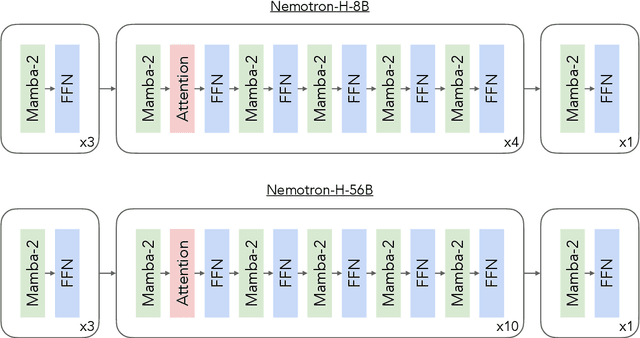
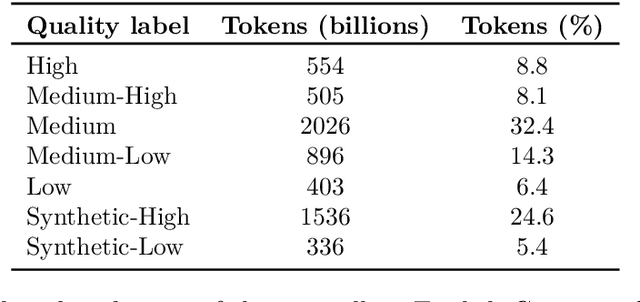
Abstract:As inference-time scaling becomes critical for enhanced reasoning capabilities, it is increasingly becoming important to build models that are efficient to infer. We introduce Nemotron-H, a family of 8B and 56B/47B hybrid Mamba-Transformer models designed to reduce inference cost for a given accuracy level. To achieve this goal, we replace the majority of self-attention layers in the common Transformer model architecture with Mamba layers that perform constant computation and require constant memory per generated token. We show that Nemotron-H models offer either better or on-par accuracy compared to other similarly-sized state-of-the-art open-sourced Transformer models (e.g., Qwen-2.5-7B/72B and Llama-3.1-8B/70B), while being up to 3$\times$ faster at inference. To further increase inference speed and reduce the memory required at inference time, we created Nemotron-H-47B-Base from the 56B model using a new compression via pruning and distillation technique called MiniPuzzle. Nemotron-H-47B-Base achieves similar accuracy to the 56B model, but is 20% faster to infer. In addition, we introduce an FP8-based training recipe and show that it can achieve on par results with BF16-based training. This recipe is used to train the 56B model. All Nemotron-H models will be released, with support in Hugging Face, NeMo, and Megatron-LM.
InstructRetro: Instruction Tuning post Retrieval-Augmented Pretraining
Oct 11, 2023Abstract:Pretraining auto-regressive large language models (LLMs) with retrieval demonstrates better perplexity and factual accuracy by leveraging external databases. However, the size of existing pretrained retrieval-augmented LLM is still limited (e.g., Retro has 7.5B parameters), which limits the effectiveness of instruction tuning and zero-shot generalization. In this work, we introduce Retro 48B, the largest LLM pretrained with retrieval before instruction tuning. Specifically, we continue to pretrain the 43B GPT model on additional 100 billion tokens using the Retro augmentation method by retrieving from 1.2 trillion tokens. The obtained foundation model, Retro 48B, largely outperforms the original 43B GPT in terms of perplexity. After instruction tuning on Retro, InstructRetro demonstrates significant improvement over the instruction tuned GPT on zero-shot question answering (QA) tasks. Specifically, the average improvement of InstructRetro is 7% over its GPT counterpart across 8 short-form QA tasks, and 10% over GPT across 4 challenging long-form QA tasks. Surprisingly, we find that one can ablate the encoder from InstructRetro architecture and directly use its decoder backbone, while achieving comparable results. We hypothesize that pretraining with retrieval makes its decoder good at incorporating context for QA. Our results highlights the promising direction to obtain a better GPT decoder for QA through continued pretraining with retrieval before instruction tuning.
Retrieval meets Long Context Large Language Models
Oct 04, 2023



Abstract:Extending the context window of large language models (LLMs) is getting popular recently, while the solution of augmenting LLMs with retrieval has existed for years. The natural questions are: i) Retrieval-augmentation versus long context window, which one is better for downstream tasks? ii) Can both methods be combined to get the best of both worlds? In this work, we answer these questions by studying both solutions using two state-of-the-art pretrained LLMs, i.e., a proprietary 43B GPT and LLaMA2-70B. Perhaps surprisingly, we find that LLM with 4K context window using simple retrieval-augmentation at generation can achieve comparable performance to finetuned LLM with 16K context window via positional interpolation on long context tasks, while taking much less computation. More importantly, we demonstrate that retrieval can significantly improve the performance of LLMs regardless of their extended context window sizes. Our best model, retrieval-augmented LLaMA2-70B with 32K context window, outperforms GPT-3.5-turbo-16k and Davinci003 in terms of average score on seven long context tasks including question answering and query-based summarization. It also outperforms its non-retrieval LLaMA2-70B-32k baseline by a margin, while being much faster at generation. Our study provides general insights on the choice of retrieval-augmentation versus long context extension of LLM for practitioners.
Shall We Pretrain Autoregressive Language Models with Retrieval? A Comprehensive Study
Apr 13, 2023



Abstract:Large decoder-only language models (LMs) can be largely improved in terms of perplexity by retrieval (e.g., RETRO), but its impact on text generation quality and downstream task accuracy is unclear. Thus, it is still an open question: shall we pretrain large autoregressive LMs with retrieval? To answer it, we perform a comprehensive study on a scalable pre-trained retrieval-augmented LM (i.e., RETRO) compared with standard GPT and retrieval-augmented GPT incorporated at fine-tuning or inference stages. We first provide the recipe to reproduce RETRO up to 9.5B parameters while retrieving a text corpus with 330B tokens. Based on that, we have the following novel findings: i) RETRO outperforms GPT on text generation with much less degeneration (i.e., repetition), moderately higher factual accuracy, and slightly lower toxicity with a nontoxic retrieval database. ii) On the LM Evaluation Harness benchmark, RETRO largely outperforms GPT on knowledge-intensive tasks, but is on par with GPT on other tasks. Furthermore, we introduce a simple variant of the model, RETRO++, which largely improves open-domain QA results of original RETRO (e.g., EM score +8.6 on Natural Question) and significantly outperforms retrieval-augmented GPT across different model sizes. Our findings highlight the promising direction of pretraining autoregressive LMs with retrieval as future foundation models. We release our implementation at: https://github.com/NVIDIA/Megatron-LM#retro
Reducing Activation Recomputation in Large Transformer Models
May 10, 2022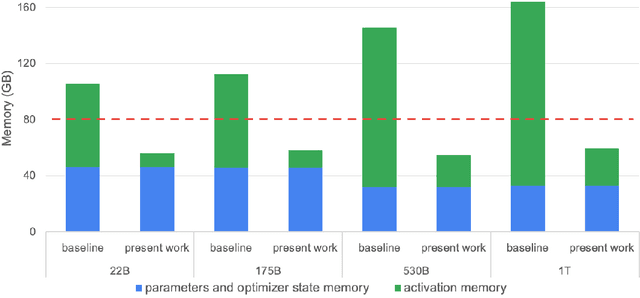


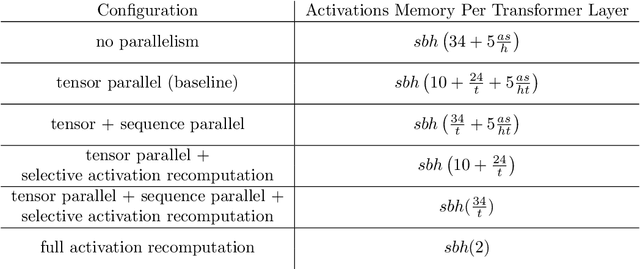
Abstract:Training large transformer models is one of the most important computational challenges of modern AI. In this paper, we show how to significantly accelerate training of large transformer models by reducing activation recomputation. Activation recomputation is commonly used to work around memory capacity constraints. Rather than storing activations for backpropagation, they are traditionally recomputed, which saves memory but adds redundant compute. In this work, we show most of this redundant compute is unnecessary because we can reduce memory consumption sufficiently without it. We present two novel yet very simple techniques: sequence parallelism and selective activation recomputation. In conjunction with tensor parallelism, these techniques almost eliminate the need to recompute activations. We evaluate our approach on language models up to one trillion parameters in scale and show that our method reduces activation memory by 5x, while reducing execution time overhead from activation recomputation by over 90%. For example, when training a 530B parameter GPT-3 style model on 2240 NVIDIA A100 GPUs, we achieve a Model Flops Utilization of 54.2%, which is 29% faster than the 42.1% we achieve using recomputation. Our implementation will be available in both Megatron-LM and NeMo-Megatron.
Utilizing Static Analysis and Code Generation to Accelerate Neural Networks
Jun 27, 2012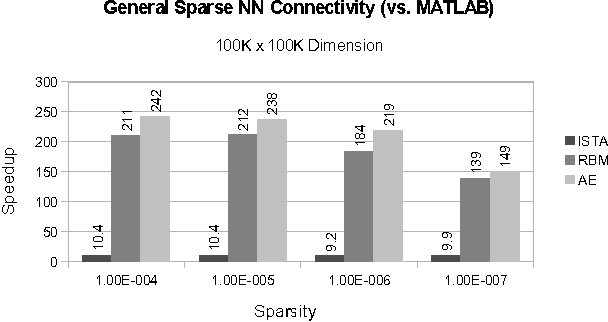
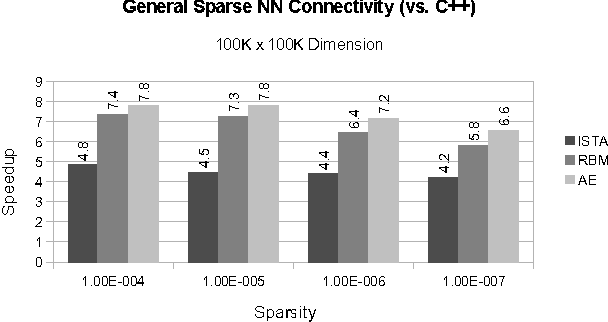
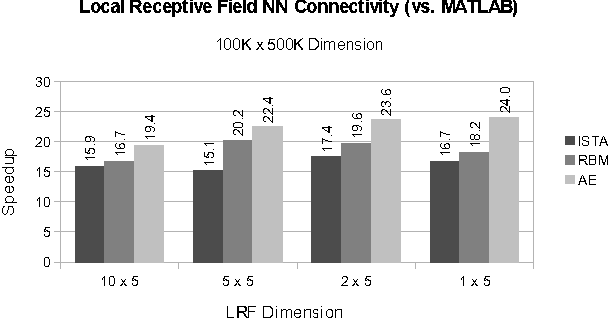
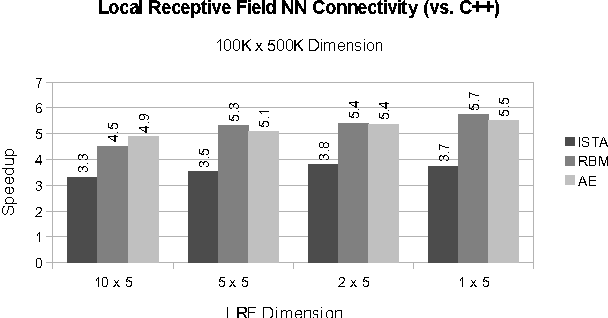
Abstract:As datasets continue to grow, neural network (NN) applications are becoming increasingly limited by both the amount of available computational power and the ease of developing high-performance applications. Researchers often must have expert systems knowledge to make their algorithms run efficiently. Although available computing power increases rapidly each year, algorithm efficiency is not able to keep pace due to the use of general purpose compilers, which are not able to fully optimize specialized application domains. Within the domain of NNs, we have the added knowledge that network architecture remains constant during training, meaning the architecture's data structure can be statically optimized by a compiler. In this paper, we present SONNC, a compiler for NNs that utilizes static analysis to generate optimized parallel code. We show that SONNC's use of static optimizations make it able to outperform hand-optimized C++ code by up to 7.8X, and MATLAB code by up to 24X. Additionally, we show that use of SONNC significantly reduces code complexity when using structurally sparse networks.
 Add to Chrome
Add to Chrome Add to Firefox
Add to Firefox Add to Edge
Add to Edge